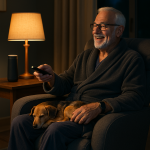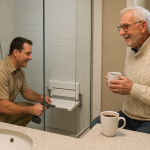When I think about growing older, I want to stay in my own home for as long as possible. That’s where smart aging comes in. It’s not about replacing everything you know with complicated gadgets. Instead, it’s about choosing the right tools to make your life easier and safer. That means using technology, good planning, and engaging in healthy habits to keep a sharp mind and your independence as you age.
Smart aging aligns well with aging in place. With the right approach, you can stay where you’re comfortable and happy. That means remaining in your own home and community as you get older.
Here’s what smart aging can offer in real life:
- Better safety through devices that track falls or emergencies.
- Monitor your health with wearable devices and telehealth visits.
- Stay connected with family and friends through video calls and messaging.
- Overall quality of life improves as you gain control over your daily routine.
The Core Principles of Smart Aging
Independence Solutions First
The most important principle of smart aging is keeping your independence. Every solution should lead to becoming less dependent on others. Smart aging devices should fit into your daily routine without causing stress or confusion.
For example, a voice assistant can turn on lights or play music with simple commands. You just speak naturally, and the device responds, there’s no need to memorize complicated instructions. This keeps you in charge of your environment.
Smart aging technology is not about making you feel helpless. The goal is to support the skills you already have. If you’re managing your medications well, a smart pill dispenser only enhances your safety. It doesn’t replace your good habits.
Not all smart devices are created equal. Here are the features that make technology easier, safer, and more enjoyable for older adults.
What to Look For in Senior-Friendly Technology
- ✔️ Simple Interfaces: Minimal menus, clear icons, and easy navigation
- ✔️ Large Text and Buttons: Easy to read and use for those with vision or dexterity concerns
- ✔️ Voice Control Options: Hands-free operation for mobility support
- ✔️ Reliable Alerts: Audible, visual, or vibration-based notifications
- ✔️ Easy Setup: Quick-start guides, videos, or assisted installation
- ✔️ Strong Support: Good customer service, manuals, and tutorials designed with seniors in mind
Safety Without Sacrificing Comfort
Safety is crucial, but your home should still feel comforting. Smart aging means finding the right balance between security and comfort. You want protection without feeling like you’re living in a medical clinic.
Smart doorbells let you see who’s at the door without having to open it. Motion sensors can alert family members if you haven’t moved around your home in a while. These devices work quietly in the background without changing the look and feel of your home.
Smart aging safety features should be invisible when you don’t need them. A fall detection device might look like a regular pendant or watch. Emergency call systems can be disguised within decorative items. As a result, you get peace of mind without constant reminders that you’re being monitored.
“VR systems allow seniors to travel virtually, practice gentle exercise routines like Tai Chi, or even attend educational lectures from home.”
Connection and Engagement
Staying connected with others is vital for healthy aging. Smart aging technology makes it easier to maintain relationships and stay mentally active. Video calling apps let you see grandchildren regardless of where they live. Social media helps you keep up with friends and community events.
Furthermore, smart aging includes tools for mental stimulation. Brain training apps, online courses, and digital libraries keep your mind sharp. These activities are fun and challenging without being overwhelming.
Home Technology for Smart Aging
Smart Home Hubs and Voice Assistants
Voice assistants are usually the first step seniors take towards smart technology. Devices like Amazon Alexa or Google Home can control many features of your home using basic voice commands. You can ask them to turn lights on or off, adjust the temperature, or play your favorite music.
These smart tools are especially helpful if mobility becomes challenging. Instead of walking to a light switch, you just say, “Turn on the living room lights.” You can lock doors, check the weather, or set reminders without getting up from your chair.
Voice assistants support smart aging in several ways, such as:
- Control lighting throughout your home
- Adjust thermostats for comfort
- Set medication reminders
- Make hands-free phone calls
- Play audiobooks or music
- Get weather updates and news
Remote Monitoring and Alerts for Smart Aging Safety
Remote monitoring systems are a cornerstone of smart aging. These devices watch for unusual patterns of movement as well as emergencies. If you fall, sensors can detect the impact and automatically call for help. Family members can receive alerts if you don’t follow your normal routine.
Motion sensors placed throughout your home create an invisible safety net. They track your daily movements without being intrusive. If your system detects unusual patterns including lack of movement, it can send an alert to your adult children.
Emergency call systems have evolved. Modern smart devices can detect falls automatically. Some even monitor heart rate and other vital signs. This gives you and your family peace of mind.
Climate and Lighting Controls for Smart Aging Comfort
Smart thermostats and lighting systems make your home more comfortable and energy efficient. These smart aging technologies learn your preferences and adjust automatically. You stay comfortable without constantly fussing over controls.
Circadian lighting systems change color temperature throughout the day. Bright, cool light in the morning helps you feel alert. Warm, dim light in the evening promotes better sleep. This supports your natural sleep-wake cycle, which is important for healthy aging.
Automated climate control keeps your home comfortable. If you forget to adjust the thermostat, the system does it for you. This prevents uncomfortable temperature swings and can even lower your energy bills.
Health and Wellness Innovations
Wearable Health Trackers
Wearable smart devices are powerful tools in smart aging. Fitness trackers and smartwatches can monitor heart rate, steps taken, and even sleep patterns. Some devices automatically share this information with your healthcare team. This early warning system can prevent serious health problems.
Sleep tracking is of particular value. Poor sleep can affect memory, mood, as well as physical and mental health. Wearable smart devices show how long and how well you sleep. You can then make changes to improve your rest.
Telehealth and Remote Consultations in Smart Aging
“Smart aging includes regular use of telehealth services. Video appointments are often just as effective as in-person visits for many conditions. You save time and energy while still getting quality care. Telehealth services are one of the most convenient and impactful additions to smart aging.”
Telehealth has revolutionized healthcare for older adults. You can consult with doctors, nurses, and specialists from the comfort of your own home. This is especially valuable if you have mobility issues, live in a rural area, or face severe weather that can make travel difficult.
Remote monitoring devices can share data directly with your healthcare team. Blood pressure monitors, glucose meters, and pulse oximeters can transmit readings automatically. Your doctor sees trends and changes without waiting for your next appointment.
Medication Reminders and Dispensers
Medication management is a critical aspect of smart aging. Smart pill dispensers organize your medications and remind you when to take them. Some devices even call family members if you miss a dose.
These smart aging tools prevent dangerous medication errors. They ensure you take the right pills at the right time. Some dispensers can be programmed by your pharmacy and delivered to your home.
Smartphone apps also help with medication management. They send notifications, track side effects, and provide drug interaction warnings. This information helps you and your doctor make informed decisions about your care.
This ensures safer, simpler medication routines that reduce stress and improve outcomes.
Assistive Devices That Support Smart Aging
Mobility Aids Get Smart
Traditional mobility aids have gotten smarter. GPS-enabled canes help you navigate unfamiliar areas. They can even alert family members if you wander outside a safe zone.
Smart walkers include features like built-in seats, LED lights, and emergency call buttons. Some models have storage compartments and even small coolers for medications. These improvements make mobility aids more useful and appealing.
Foldable walkers with smart features are perfect for active seniors. They collapse for easy transport but include safety features like lights and alarms. This supports smart aging by encouraging independence and mobility.
Hearing and Vision Aids
Digital hearing aids now connect to smartphones and other devices. You can adjust settings through an app or stream phone calls directly to your ears. This makes communication easier and more natural.
Smart glasses are emerging as valuable smart tools. Some models magnify text automatically. Others provide audio descriptions of your surroundings. These devices help people with vision problems stay independent.
Text-to-speech apps turn written words into spoken language. This helps if reading becomes difficult. You can listen to emails, text messages, and even books with these applications.
Kitchen Safety Devices for Smart Aging
Kitchen safety is a major concern for aging in place. Smart stovetop shut-off systems turn off burners automatically if they detect unsafe conditions. This prevents fires and gives family members peace of mind.
Sensor-based appliance alerts notify you if the refrigerator door is left open or if the oven is still on. These simple smart devices prevent waste and dangerous situations.
Smart smoke and carbon monoxide detectors provide early warnings and can contact emergency services automatically. They’re much more sensitive than traditional detectors and can distinguish between cooking smoke and real fires.
Smart Aging Technology and Lifestyle Practices
“Don’t underestimate the brain-boosting power of hobbies. Whether it’s painting, woodworking, quilting, or tackling a passion project you’ve put off for years, creative expression keeps your mind engaged and your spirit energized. These activities aren’t just enjoyable—they help improve focus, memory, and emotional well-being. That’s smart aging at its finest.”
Brain Fitness Activities
Building a sharper mind is just as important as building a strong body. Brain training apps provide puzzles, memory games, and problem-solving activities. These exercises are fun and can improve cognitive function.
Online courses and educational videos offer lifelong learning opportunities. You can explore new subjects or revisit old interests from the comfort of your home. This mental stimulation is a key component of smart aging.
Some samples of brain fitness activities can include:
- Crossword puzzles and word games
- Memory training exercises
- Online language learning
- Virtual museum tours
- Digital photography classes
Activity and Home Fitness
Staying physically active becomes more important as we age. Smart aging includes home fitness technology that makes exercise safer and more enjoyable. Resistance bands with built-in trackers show your progress and proper form.
Chair exercises and gentle yoga videos are perfect for people with mobility limitations. Smart fitness equipment adjusts to your ability level and provides encouragement. This makes it easier to maintain regular exercise routines.
Balance-focused apps are a fun, low-impact way to reduce fall risk while building confidence, which is crucial for smart aging. These programs use your smartphone or tablet to guide you through stability exercises. Regular practice can significantly reduce fall risk.
Healthy Home Habits
Air quality monitors help you maintain a healthy home environment. They detect pollutants, allergens, and humidity levels. Some devices automatically adjust air purifiers or notify you when to open windows.
Hydration reminders are simple but effective smart tools considering many people don’t drink enough water during the day—especially as they get older. Smart water bottles or smartphone apps can remind you to drink water throughout the day.
Sleep optimization is another important aspect of smart aging. Smart mattresses and pillows adjust to your body position and track sleep quality. This information helps you recognize patterns and make changes for better rest.
Smart aging isn’t only about devices—it’s also about the small, intentional habits that support brain health, emotional balance, and physical strength.
Daily Habits That Support Smart Aging
- Mental Activity: Brain games, learning new skills, and creative hobbies
- Physical Movement: Gentle exercise like yoga, walking, or chair workouts
- Social Interaction: Phone calls, virtual chats, or small in-person visits
- Quality Sleep: Using routines and smart lighting to support restful nights
- Hydration & Nutrition: Drinking enough water and eating balanced meals
Plan Your Smart Aging Roadmap
Assess Your Needs and Goals
Make a list of your daily challenges and concerns. Then research smart aging solutions that address these specific issues. This targeted approach prevents you from buying unnecessary gadgets.
Start by deciding which features matter most to you:
- Better safety
- Health monitoring
- Staying connected to others
Everyone’s needs are different, but most people tend to prioritize a few key areas when it comes to aging in place with the help of smart technology.
Top Smart Aging Priorities Among Seniors
- ✔️ Safety: Fall prevention, emergency alerts, and home monitoring
- ✔️ Health Monitoring: Wearables, medication reminders, and telehealth access
- ✔️ Independence: Voice assistants, smart lighting, and easy-to-use devices
- ✔️ Comfort: Automated thermostats and circadian lighting
- ✔️ Connection: Video calls, messaging, and mental stimulation tools
Start Small and Build Your Smart Aging System
A gradual approach is the key to success. Choose one or two devices to begin with. Learn how to use them well before adding more technology. Start with devices that address your immediate concerns. If safety is your main worry, begin with a medical alert system or fall detection device. If staying connected is most important, start with a tablet for video calls.
Once you’re comfortable with your first devices, gradually add new ones. This allows you get the most out of each new device without becoming overwhelmed.
“Consider your comfort level with technology. If you’re new to smart devices, start with simple solutions.”
Budget and Support Considerations
Smart technology ranges from affordable to expensive. Create a budget and prioritize the most important devices first. Remember that many smart aging solutions can save money in the long run by preventing emergencies or reducing healthcare costs. Look for devices with good warranties and customer support. Look for brands that offer clear instructions and ongoing support.
Consider insurance coverage and assistance programs. Some health insurance plans cover certain smart devices. Veterans’ benefits and senior assistance programs might also help with costs.
Overcoming Common Barriers to Smart Aging
Avoiding Tech Overload
Technology can feel overwhelming, especially if you’re new to digital devices. The key to successful smart aging is choosing simple, intuitive products. Look for smart devices with uncluttered interfaces, large buttons, clear displays, and straightforward instructions. Start with one device at a time. Master its basic functions before adding layers of complexity.
“Most smart technologies have simple modes that hide advanced features until you’re ready for them.”
Ask family members or friends for help with setup and initial learning. Many companies also offer training sessions or online tutorials specifically designed for seniors. Start with tools that simplify your life, not complicate it—and build from there.
Not sure where to begin? This simple chart shows how a few small tech upgrades can solve some of the most common aging-in-place challenges.
Smart Tech Fixes for Everyday Challenges
| Challenge | Smart Aging Solution |
|---|---|
| Forgetting medication | Smart pill dispensers and reminder apps |
| Trouble getting up to turn off lights | Voice-controlled lighting systems |
| Feeling isolated | Video calling, virtual hobby groups, and social apps |
| Difficulty tracking health trends | Wearable health monitors synced to mobile apps |
Addressing Privacy Concerns
Privacy and security are legitimate concerns with smart aging technology. Here are some suggestions:
- Choose reputable companies that prioritize data protection.
- Read privacy policies and understand what information is collected and shared.
- Use strong passwords and enable two-factor authentication when available.
- Keep your smart devices current with regular software updates.
- Discuss privacy settings with family members involved in your care.
Building Confidence Through Gradual Smart Aging Adoption
Reluctance to change is natural, especially with unfamiliar technology. Build confidence by starting with devices similar to things you already use. If you’re comfortable with a basic cell phone, a simple tablet might be your next step. Practice using new devices during quiet, low-stress moments. Don’t pressure yourself to master everything immediately. The key to success is gradual consistent practice.
Celebrate the small victories as you adopt smart technology. Successfully making a video call or using voice commands to turn on lights are accomplishments worth acknowledging.
Smart Aging as a Journey
Smart aging isn’t a destination—it’s a continuous process. Technology will continue to evolve, and your needs will change over time. The key is staying flexible and open to new solutions. Regularly reassess your smart technology setup. Are your current devices still meeting your needs? Have new health concerns emerged that require different technology? This periodic evaluation ensures your smart aging system remains effective.
Stay informed about new smart tech developments through newsletters, websites, and conversations with healthcare providers. You don’t need to adopt every new device, but awareness helps you make informed decisions.
Remember that smart aging is about adaptation, not perfection. Some technologies will suit you perfectly, others may not—and that’s okay. If a device doesn’t add value to your life, simply stop using it.
Living Smarter, Not Just Longer Through Smart Aging
Smart aging represents a powerful approach to maintaining independence and quality of life as we grow older. By thoughtfully combining technology with healthy lifestyle choices, we can age gracefully in our own homes.
The goal isn’t to live longer just for the sake of more years. Instead, smart aging focuses on making those years more fulfilling, safer, and more connected. When we use technology wisely, we enhance our daily experiences rather than complicate them.
Your journey will be unique to your needs, goals, and situation. You need to:
- Start where you are
- Use what works for your lifestyle and comfort level
- Build gradually
There’s no perfect starting point—only your own. The most important step is simply beginning.
Final Thoughts
Whether you’re exploring assistive devices for seniors or researching the latest tech for seniors, remember that smart ageing is about empowering yourself. It’s about staying in control of your environment, your choices, and your future—while knowing help is always within reach.
The future of aging in place looks brighter with smart aging strategies. By embracing helpful technology and maintaining healthy habits, we can all look forward to golden years that are truly golden.






